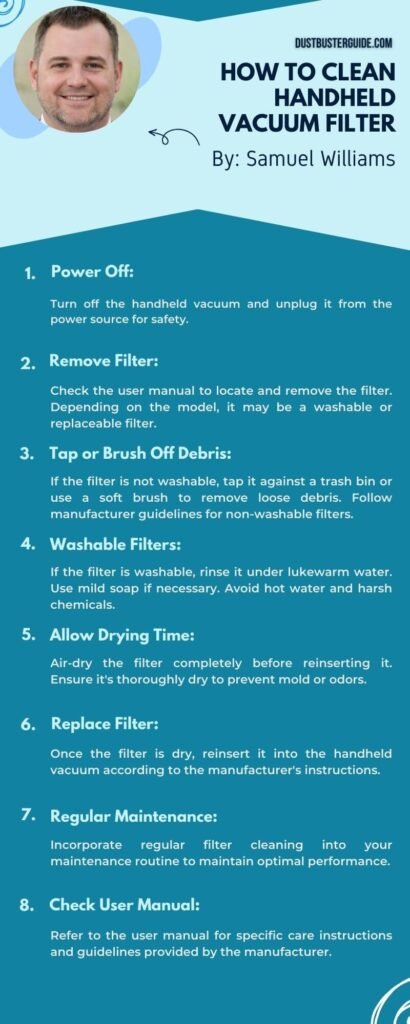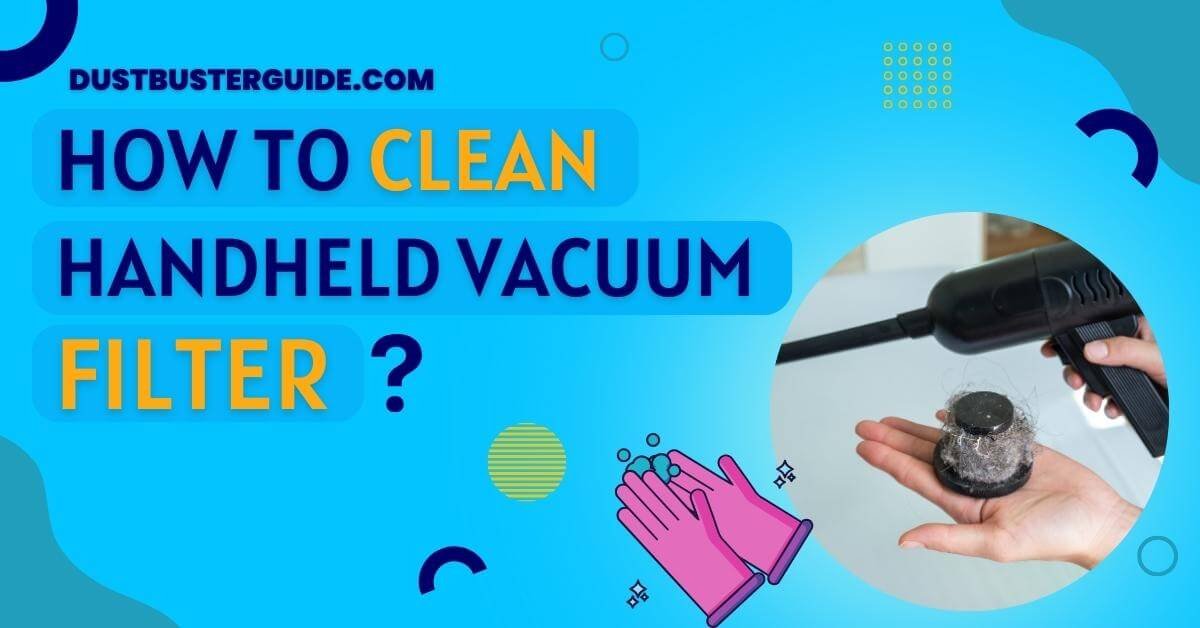The handheld hygiene query prompts a question of filter finesse: how to clean handheld vacuum filter? It’s an exploration into the art of maintaining peak performance for your trusty handheld cleaning companion.
Picture this: your handheld vacuum after a series of small mess rescues, and the question arises. In just a couple of lines, the answer breezes in like a cleaning revelation: Remove the filter, gently tap off excess dust, wash it with mild soap and water, ensure it’s completely dry, and reassemble.
Your handheld vacuum is now refreshed and ready for more cleaning adventures. Join us on this exploration for a guide on keeping your handheld vacuum in tip-top shape.
What Is The Importance Of Cleaning Your Vacuum Filter
You might not realize it, but regularly cleaning your vacuum filter can significantly improve your cleaning routine, leaving you with a more hygienic and fresh-smelling home. A clean filter helps your vacuum to work at its full capacity, ensuring that it picks up more dust, dirt, and allergens from your carpet and upholstery.
Over time, a clogged or dirty filter can hinder the vacuum’s suction power, reducing its efficiency and possibly leading to longer cleaning times or subpar results. Not only that, but a dirty filter can also strain the vacuum’s motor, potentially shortening its lifespan.
Moreover, a clean vacuum filter contributes to better air quality in your home. While vacuuming, your machine’s filter should trap and retain dust particles and allergens, preventing them from being released back into the air.
However, if your filter is clogged or dirty, it may not be able to perform this function effectively, causing these unwanted particles to be blown back into your living space.
Regularly cleaning your vacuum filter can help to minimize this, leading to cleaner, healthier air for you and your family.
When To Clean Your Handheld Vacuum Filter
It’s essential to determine the right time for maintaining your portable suction device’s filtration system. Regular maintenance is crucial for ensuring that your handheld vacuum operates at peak performance.
The frequency of cleaning depends on how often you use the vacuum and the type of debris you typically pick up. Most manufacturers advise cleaning the filter after every 3-6 uses, but if your vacuum is picking up a lot of dust or pet hair, you might need to clean it more frequently.
When you notice that your vacuum isn’t picking up debris as efficiently as it usually does, it’s a sign that you should check and possibly clean the filter. Furthermore, if the vacuum starts emitting a strange smell or becomes unusually loud, this could indicate that the filter is clogged and needs cleaning.
However, you shouldn’t wait for these signs before cleaning your filter. It’s always better to maintain a consistent cleaning schedule to ensure your vacuum stays in good working condition.
What Tools Are Needed For Cleaning
Rolling up your sleeves to tackle that dirty filter? Let’s talk about the essential tools you’ll need for the job.
Cleaning a handheld vacuum filter doesn’t require an extensive toolkit. You’ll likely have most of what you need at home. Two basic yet essential items you’ll need are a soft-bristled brush for gentle scrubbing and a clean cloth. The brush will help you dislodge any stubborn dirt from the filter, while the cloth is for wiping and drying purposes.
If your filter is washable (check your vacuum’s manual if unsure), you’ll also need warm water and mild detergent. These will aid in the thorough cleansing of the filter. A sink or a large bowl would also come in handy for soaking the filter if necessary.
Lastly, you’ll need a dry, well-ventilated area to let the filter air dry after cleaning. Note that using a hairdryer or direct sunlight to speed up the drying process isn’t recommended as it could damage the filter.
| Tools | Description |
| Soft-Bristled Brush | For gentle scrubbing to dislodge dirt from the filter. |
| Clean Cloth | For wiping and drying the filter. |
| Warm Water | For washing the filter, if it’s washable. |
| Mild Detergent | is Used with warm water for thorough cleansing of the filter. |
| Sink or Large Bowl | For soaking the filter if necessary. |
| Well-Ventilated Area | To air dry the filter after cleaning, avoid using a hairdryer or direct sunlight. |
Step-By-Step Guide On How To Clean Handheld Vacuum Filter
Ready to dive into the nitty-gritty of cleaning your handheld vacuum filter? We’re about to embark on a step-by-step journey, guiding you through the process of disconnecting and removing the filter.
Thoroughly clean it and finally, ensure it’s correctly dried. Stick around because this is a task you’ll want to get right to ensure the longevity and efficiency of your vacuum.
1. Disconnecting And Removing The Filter
Before diving into the cleaning process, you’ll need to disconnect and remove the filter from your handheld vacuum carefully. This step is crucial as mishandling the filter can potentially damage it, reducing its efficiency or rendering it unusable.
Each vacuum model is different, so be sure to refer to the user manual for specific instructions. In general, most filters can be accessed by removing the dust cup or dirt bin. Once the container is off, you should see the filter, which can usually be removed by simply pulling it out.
Now that you’ve successfully removed the filter, do a quick inspection to check its condition. If it’s visibly dirty or noticeably less effective, it’s time for a good clean. However, if your filter is damaged or excessively worn out, you might need to replace it completely.
Remember, it’s essential to handle the filter gently to avoid any unnecessary harm. After all, a clean and well-maintained filter is key to your vacuum’s performance. So, pay attention to its state and clean it regularly to ensure your handheld vacuum continues to function at its best.
2. Cleaning The Filter
Let’s dive right into the nitty-gritty of giving your device’s dust-trap a thorough scrubbing. The first step is to tap the filter gently to dislodge any loose dust or dirt. Do this over a trash bin to avoid creating a mess.
If your handheld vacuum comes with a washable filter, you can rinse it under lukewarm water. Remember, it’s crucial not to use any cleaning agents or soaps as they can damage the filter material. Just plain water will do the trick.
After rinsing, shake the filter to remove excess water and then leave it to air dry. This is an important step as using a damp or wet filter can damage your vacuum and reduce its efficiency. Make sure the filter is completely dry before you reassemble your handheld vacuum. This could take anywhere from 24 to 48 hours, so it’s best to plan your cleaning accordingly.
If your vacuum has multiple filters, repeat this process for each one. Always refer to the manufacturer’s instructions for any specific cleaning guidelines.
3. Drying The Filter
You might be wondering how long it takes for your device’s dust trap to fully dry. Well, the answer largely depends on the type of filter your handheld vacuum uses.
Typically, a washable filter made from foam or fabric needs at least 24 hours to dry completely. However, it’s important to remember that this timeframe can vary depending on your local climate and current weather conditions. In a dry, warm environment, your filter may dry faster, while in a more humid or cold environment, it might take a bit longer.
When it comes to drying the filter, always let it air dry completely before you put it back into your vacuum. This is crucial because a damp or wet filter can potentially damage your vacuum’s motor.
To speed up the drying process, place the filter in a well-ventilated area or near a source of gentle heat, like a sunny window. But remember, never use a hairdryer or place the filter directly on a heat source as this could cause it to warp or even melt.

How To Reassemble Your Vacuum Properly
After taking apart your handheld vacuum for a thorough cleaning, it’s crucial to put it back together correctly to ensure it functions at its best.
- Begin by placing the filter back into the vacuum, ensuring it fits snugly and securely in its designated slot. If your vacuum has a pre-filter, this should be replaced before the main filter.
- Always make sure you’re not forcing any parts into place; they should all fit together smoothly and easily.
- Next, replace the dust cup or bag if your vacuum uses one. Ensure it’s securely attached before moving on.
- Finally, put any other removable parts back where they belong. Take a moment to double-check everything before turning your vacuum back on.
Remember, incorrectly reassembling your vacuum can cause damage or diminish its cleaning performance, so it’s worth taking the time to do it right.
Regular Maintenance Tips For Your Vacuum
Regular care and maintenance are key to prolonging the life and efficiency of your dust-busting equipment. Always remember to empty the dust cup after every use, as allowing debris to accumulate can harm your vacuum’s performance and might even cause motor damage.
If the dust cup is washable, it’s best to clean it with warm water and let it air dry thoroughly before reassembling. Don’t forget the exterior of your vacuum too; it should also be kept clean with the help of a damp cloth.
In addition to cleaning the dust cup and the exterior, pay attention to the filters. The filters of your handheld vacuum play a crucial role in trapping dust and allergens, thus ensuring cleaner and healthier surroundings. Consequently, these filters should be cleaned regularly.
Most handheld vacuums have washable filters; these can be cleaned by rinsing under warm water. Remember to let the filter air dry completely before putting it back in the vacuum. If your vacuum filters are not washable, you should replace them as per the manufacturer’s recommendation.
What To Do If Your Filter Is Damaged Or Worn Out

If your dust-trapping component is showing signs of damage or wear, it’s time to think about a replacement. Even the best handheld vacuum filters aren’t invincible and will eventually need to be replaced. Delaying this process can lead to a reduction in your device’s suction power and overall performance.
In addition, a damaged filter can allow dust particles, allergens, and other pollutants to escape back into your living environment, causing potential health issues.
When shopping for a new filter, ensure you choose a suitable replacement that fits your specific vacuum model. Check the manufacturer’s specifications or consult the user manual for guidance. Once you’ve purchased your new filter, follow the manufacturer’s instructions for installation.
Remember, regular replacement of your vacuum filter not only ensures optimal performance of your handheld vacuum but also contributes to a healthier, cleaner living space.
What Happens If You Don’t Clean Vacuum Filter
If you don’t clean your vacuum filter, it can impact the performance of the vacuum. Dirty vacuum filters can restrict airflow, so the suction won’t be as strong. Over time, the filter can become clogged with dirt, dust, and debris, which can cause the vacuum to overheat and potentially damage the motor.
Additionally, a clogged filter can cause the vacuum to emit unpleasant odors and reduce the overall air quality in your home. To avoid these issues, it’s essential to clean or replace your vacuum filter regularly, according to the manufacturer’s recommendations.
For example, foam vacuum filters that can be washed should be gently cleaned by hand with warm water and a drop of dish soap. Make sure the vacuum filter is completely dry before being put back into the vacuum for use. If a vacuum filter is even a little damp, mold and mildew can grow, and your vacuum will stink when you use it next.
Conclusion
So now you know how to clean handheld vacuum filter. Keeping your handheld vacuum filter clean isn’t just about maintaining its efficiency. It also extends the lifespan of your device and helps you save money in the long run.
Regular maintenance is key, so don’t overlook the importance of this simple task.
If you ever find your filter damaged or worn out, don’t worry. Replacement filters are easily available, and changing them is just as straightforward as the cleaning process.
You’ve got this!
FAQs
How often should I clean my handheld vacuum filter?
You should clean your handheld vacuum filter every 1-2 months, depending on usage. Regular cleaning ensures optimal performance and prevents clogs. Follow the manufacturer’s instructions for the specific cleaning process.
Can I use soap or detergent to clean my vacuum filter?
Yes, you can use soap or detergent to clean your vacuum filter. It helps remove dirt and grime effectively. Just make sure to rinse it thoroughly and let it dry completely before reattaching it to your handheld vacuum.
Can I wash my vacuum filter in the dishwasher?
Yes, you can wash your vacuum filter in the dishwasher. Simply remove the filter and place it in the dishwasher, using a gentle cycle with mild detergent. Make sure it’s completely dry before reattaching it to the vacuum.
Should I replace my vacuum filter if it looks dirty even after cleaning?
Yes, you should replace your vacuum filter if it still looks dirty even after cleaning. A dirty filter can affect the vacuum’s performance and may not effectively trap dust and allergens.
Can I use compressed air to clean my handheld vacuum filter?
Yes, you can use compressed air to clean your handheld vacuum filter. Simply blow the air through the filter to remove any dirt or debris. This method is effective in removing stubborn particles.
How do you clean a nonwashable vacuum filter?
To clean a non-washable vacuum filter, use a vacuum cleaner hose with a brush attachment to remove contaminants from the filter, or tap the filter against a garbage can to loosen debris caught between the pleats.
How do you get dust out of a vacuum filter?
To get dust out of a vacuum filter, remove the filter from the vacuum and tap all loose dirt into the garbage, then rinse the outside of the filter with lukewarm water and allow it to air dry before reinserting it into the vacuum.
External Resources
- Comparing The Recommendations Of Buyers Of Energy-Efficient And Inefficient Vacuum Cleaners – MDPI
- The Best Robot Vacuum You Can Buy Right Now – The Verge
- The Design Methodology To Develop New-Generation Universal-Motors For Vacuum Cleaners – IEEE Xplore
- The Effect Of Vacuum Cleaners On The Concentration And Particle Size Distribution Of Airborne Cat Allergen – The Journal of Allergy and Clinical Immunology

